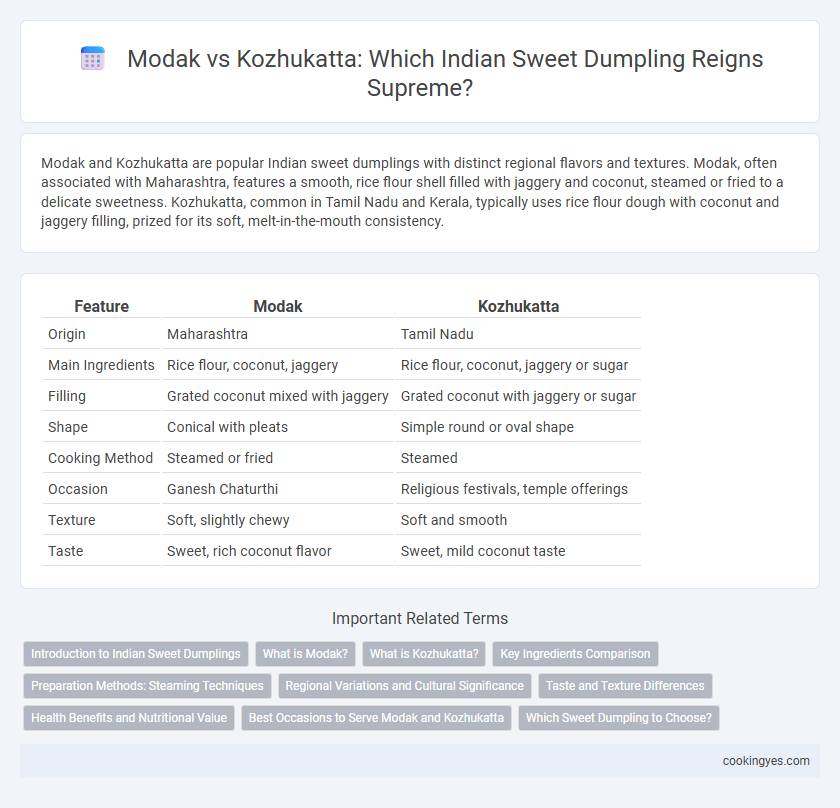Modak and Kozhukatta are popular Indian sweet dumplings with distinct regional flavors and textures. Modak, often associated with Maharashtra, features a smooth, rice flour shell filled with jaggery and coconut, steamed or fried to a delicate sweetness. Kozhukatta, common in Tamil Nadu and Kerala, typically uses rice flour dough with coconut and jaggery filling, prized for its soft, melt-in-the-mouth consistency.
Table of Comparison
| Feature | Modak | Kozhukatta |
|---|---|---|
| Origin | Maharashtra | Tamil Nadu |
| Main Ingredients | Rice flour, coconut, jaggery | Rice flour, coconut, jaggery or sugar |
| Filling | Grated coconut mixed with jaggery | Grated coconut with jaggery or sugar |
| Shape | Conical with pleats | Simple round or oval shape |
| Cooking Method | Steamed or fried | Steamed |
| Occasion | Ganesh Chaturthi | Religious festivals, temple offerings |
| Texture | Soft, slightly chewy | Soft and smooth |
| Taste | Sweet, rich coconut flavor | Sweet, mild coconut taste |
Introduction to Indian Sweet Dumplings
Indian sweet dumplings such as Modak and Kozhukatta are traditional delicacies with rich cultural significance, especially during festivals like Ganesh Chaturthi. Modak, primarily popular in Maharashtra, features a delicate rice flour shell filled with coconut, jaggery, and cardamom, while Kozhukatta from Tamil Nadu uses a similar dough but often incorporates distinct regional fillings like coconut and jaggery or lentils. Both dumplings celebrate Indian culinary heritage through their unique textures, flavors, and regional variations, showcasing the diversity of traditional Indian sweets.
What is Modak?
Modak is a traditional Indian sweet dumpling primarily associated with the festival of Ganesh Chaturthi, made from rice flour or wheat flour dough filled with a mixture of jaggery and grated coconut. It is steamed or fried and is revered as Lord Ganesha's favorite offering. Unlike Kozhukatta, which varies regionally in shape and filling, Modak generally features a distinct conical shape symbolizing spirituality and devotion.
What is Kozhukatta?
Kozhukatta is a traditional South Indian sweet dumpling made from rice flour dough filled with a mixture of grated coconut and jaggery, steamed to perfection. It is particularly popular in Tamil Nadu and Kerala during festivals like Ganesh Chaturthi, symbolizing auspicious offerings. Unlike Modak, which can have a variety of fillings and distinctive shapes, Kozhukatta is simpler in presentation and emphasizes natural sweetness and texture from its core ingredients.
Key Ingredients Comparison
Modak and Kozhukatta are traditional Indian sweet dumplings with distinct key ingredient profiles; Modak typically features rice flour dough filled with jaggery and grated coconut, while Kozhukatta often uses a similar rice flour shell but includes variations in the filling like coconut mixed with cardamom or chana dal. Both sweets emphasize the use of jaggery as a natural sweetener and coconut for texture and flavor, yet Kozhukatta fillings sometimes incorporate lentils or spices to enhance taste complexity. The choice of ingredients reflects regional preferences and rituals, distinguishing Modak's sweeter, simpler filling from Kozhukatta's more diverse and spiced components.
Preparation Methods: Steaming Techniques
Modak and Kozhukatta, traditional Indian sweet dumplings, both utilize steaming techniques but differ in preparation nuances. Modak typically involves a rice flour dough filled with coconut and jaggery, steamed in a special modak mold or wrapped in turmeric leaves for aroma. Kozhukatta, predominantly from Tamil Nadu, uses a similar rice flour dough but is often shaped by hand and steamed in banana leaves, which infuse subtle flavors and prevent sticking.
Regional Variations and Cultural Significance
Modak and Kozhukatta, both Indian sweet dumplings, reflect distinct regional traditions with Modak predominantly linked to Maharashtra and Kozhukatta to Tamil Nadu and Kerala. Modak is famously associated with the Ganesh Chaturthi festival in Maharashtra, symbolizing sweetness and prosperity, while Kozhukatta holds religious significance in South Indian rituals, particularly during Ganesh Chaturthi and Vishu celebrations. The variations in ingredients and preparation methods showcase the diverse cultural identities and culinary heritage across India's regions.
Taste and Texture Differences
Modak offers a soft, sweet filling of jaggery and coconut encased in a delicate, slightly chewy rice flour shell, delivering a balanced taste of sweetness and subtle graininess. Kozhukatta, on the other hand, features a denser texture with a slightly firmer rice flour outer layer, often filled with coconut and jaggery but with variations that include spices like cardamom, enhancing its aromatic profile. While both share a similar sweetness, Modak provides a lighter, melt-in-the-mouth experience, whereas Kozhukatta presents a more substantial bite with a richer, spiced flavor complexity.
Health Benefits and Nutritional Value
Modak and Kozhukatta offer distinct health benefits rooted in their traditional ingredients, with Modak typically made from rice flour and jaggery, providing a good source of iron and carbohydrates for energy. Kozhukatta, often steamed and filled with coconut and jaggery, delivers dietary fiber, essential minerals, and healthy fats that support digestive health and sustained energy release. Both sweets are low in fat due to steaming, making them healthier options compared to fried desserts.
Best Occasions to Serve Modak and Kozhukatta
Modak is traditionally served during Ganesh Chaturthi, symbolizing devotion to Lord Ganesha, making it the perfect sweet dumpling for religious festivals and family gatherings. Kozhukatta, popular in Kerala during the festival of Onam and Hindu fasting days, is ideal for auspicious occasions and temple offerings due to its steamed preparation and use of rice flour. Both Modak and Kozhukatta complement cultural celebrations, with Modak suited for spiritual ceremonies and Kozhukatta favored in regional rituals and seasonal festivals.
Which Sweet Dumpling to Choose?
Modak and Kozhukatta are traditional Indian sweet dumplings with distinct regional flavors and fillings, making the choice dependent on taste preferences. Modak, popular in Maharashtra, typically features a rice flour shell filled with coconut and jaggery, prized during Ganesh Chaturthi for its soft, aromatic sweetness. Kozhukatta, common in South India, often includes coconut, jaggery, and sometimes lentils, known for its slightly firmer texture and steamed preparation, offering a different tactile experience in Indian festive cuisine.
Modak vs Kozhukatta for Indian sweet dumplings Infographic

 cookingyes.com
cookingyes.com